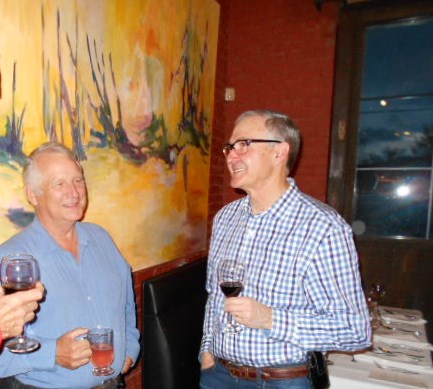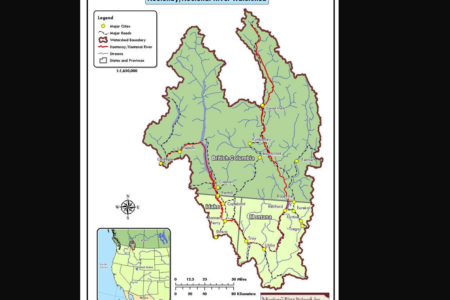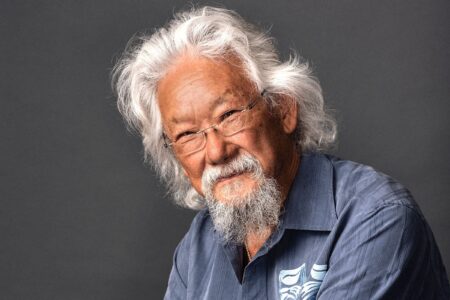Food for Thought: A Local Feast
The food was amazing. It was all local and most of it was organic. We gathered at the old fire-hall in Rossland on October 10th for a feast to raise awareness of what is being grown locally, and to consider the potential for growing and processing more local agricultural products.
Gina Ironmonger, who was a principal organizer of the event, spoke about the need for greater food security, and how increasing local agricultural production (especially of organic food) could be an economic driver once again and could also become an attraction for visitors. Ironmonger spoke of the damage done to California’s agricultural sector and the American mid-west by the prolonged drought, and of the inflationary effect we are noticing on the retail price of food. She spoke of the amount of agricultural land currently unused in our region. She urged municipal leaders to encourage home vegetable gardening and “back-yard chickens” to make our residents more resilient and food-secure.
I note that local and regional governments have the power of zoning land to ensure that it is used appropriately. They have the power to ensure that changes to the Agricultural Land Reserve legislation and Commission do not further erode the agricultural capacity of our area. It is encouraging that many local and regional governments now understand that the “highest and best use” of land is not necessarily as the site of a mall, subdivision, or casino.
The dinner:
The menu included appetizers of crostini, chicken liver mousse, chicken chorizo and spicy sauces. Attendees sipped a refreshing rhubarb cordial or wines from two local wineries as they nibbled and mingled, then sat down to begin with slices of hearty brown bread with butter; then, a delicate butternut squash soup; a delicious salad of spaghetti squash with smoked tomato vinaigrette and little green pea shoots; a main dish of tender and tasty goat braised in red wine, with roasted potatoes, carrots, beets, and little sweet peppers. Dessert was pumpkin pie with whipped cream. All the food and beverages were grown and produced locally. Everything served was bursting with flavour.
Chef John Premier and his able helpers outdid themselves in showcasing these local products of Earthy Organics, of Fruitvale; Moon Gravity Farm of Rossland; Thrive Micro Greens of Trail; Rainbow Recovery Farm of Casino; and — for the wines — Soahc Estate and Columbia Gardens Vineyard and Winery, both of Fruitvale.
Protein from what?
After the meal, the Green Party candidate for this riding, Samantha Troy, passed around a tray of little carrot cup-cakes that included cricket flour as an ingredient. They were delicious, and given what we already know about the protein-rich nutritional profile of crickets, probably more nourishing than the average carrot cake. Troy is beginning to “farm” crickets in her home, and hopes eventually to form a business selling the powdered crickets for baking, smoothies, and so on.
Why organic? A discussion:
Conversation at our table turned to soil, and how we grow food, and the merits of organic food.
Many people are now avoiding wheat and other sources of gluten in their diets, and feeling better for it. We have all heard a lot about “GMOs” — genetically modified organisms. All GMOs used agriculturally in Canada are modified to be “Roundup-Ready” — able to withstand the herbicide Round-Up, according to a scientist who worked for Agriculture Canada for 30 years. Glyphosate is the active ingredient of Roundup. By now most people are aware that studies have found glyphosate to be cancer-causing, and that the World Health Organization has declared it to be a carcinogen. According to the Saskatchewan department of Agriculture at this page, glyphosate herbicides are routinely sprayed on various “Roundup-Ready” crops, and also on non-“Roundup-Ready” crops to “enhance harvesting” by killing and desiccating the crops, which makes it easier to harvest them mechanically. These crops are registered to be sprayed with glyphosate herbicides such as Roundup a week or so before harvest: wheat, soybean, oat, lentil, flax, field pea, canola, dry bean, and barley.
How much glyphosate do we want to eat? Is it really dangerous, or should we believe its manufacturer, Monsanto, which claims it’s harmless? A French molecular scientist, Gilles-Eric Séralini, has been awarded the 2015 “Whistleblower Award” by the European Network of Scientists for Social and Environmental Responsibility (ENSSER), for his work indicating that glyphosate causes cancer. Other scientists attacked his initial studies as being scientifically flawed, and others have published a letter claiming that there is “no scientific consensus” about the health hazards of GMOs — or glyphosate. The former Agriculture Canada scientist mentioned above is Dr. Thierry Vrain, who has toured the country explaining the history and effects of glyphosate. Of course he too has been attacked for his ideas and there are many attempts to discredit his findings. Part of his talk is on a 40-minute YouTube video, and I found it utterly fascinating. Here’s the link: https://www.youtube.com/watch?v=yiU3Ndi6itk&feature=share
It is up to each of us to decide which of the conflicting claims we believe, or whether to believe any of them: my practice is to observe the precautionary principle. If there is some reasonable evidence that a thing may be harmful, and if I am able to avoid it, I will avoid it until such time as it is actually proven to be safe — by scientists who are not being funded by those who profit from the thing in question. I don’t know whether my health improved after I began avoiding wheat and soy because wheat and soy themselves were the problem, or whether it was because the wheat and soy I had been eating were contaminated with glyphosate and other toxins. In a while, I plan to try introducing wheat to my diet again, but it will be organic wheat.
There seems to be rising interest in avoiding foods that are blamed for various ills, and in eating organic foods rather than ones that have been sprayed with toxins and raised in soils depleted of trace elements by the use of synthetic fertilizers that fail to replenish them. Such foods are, as noted by Dr. Vrain, deemed “substantially equivalent” but they are not the same. And when they have been housed in storage facilities and shipped long distances, they don’t taste the same, either.
Questions:
My questions arise from the delicious meal at the old fire-hall, and the thoughtful conversations we enjoyed. Can the Kootenays become a destination for foodies? Could this region become self-sufficient in food production? Will people come here to taste and buy our organic vegetables and berries and value-added products? Can anyone make a living farming organically? And if not, what can we change to make it possible?
Climate Change and Food:
Around the world as well as locally, people are concerned about food production capacity and how climate change (among other factors) is impacting agriculture. The introduction to a recent report from “Food Tank” and other partners states, “Changes in climate over the last 30 years have already reduced global agricultural production one to five percent per decade globally. Higher temperatures, shifting seasons, and erratic rainfall pose significant challenges for food systems and particularly for small-scale food producers, eroding farmers’ confidence in their local knowledge of rainfall patterns and ecosystem services on which they rely. And these impacts are happening with global warming of only 0.85 degrees Celcius.”
The report goes on to explain that “Current emissions trajectories, even if governments meet their pledged reductions, may still lead the world to an average warming above 3 degrees Celsius (compared to pre-industrial levels) by the end of the century.” Each statement is footnoted to the relevant reports and studies.
Recommendations in the report speak to the whole planet, not just a relatively wealthy and resource-rich corner of North America. They include prioritizing gender equality and empowering women, supporting small-scale food production, and tackling climate change ambitiously and effectively. The 32-page report makes recommendations to governments, policy-makers, the private sector, the public and donors. I recommend clicking on the link above to check out the report and see what we can do locally.
After all, we all need to eat. As my first landlady used to urge me as she piled my plate just a bit too high, “Eat, Eat! You don’t eat, you get sick!”
























